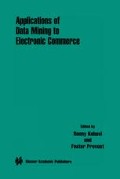Abstract
Recommender systems are being used by an ever-increasing number of E-commerce sites to help consumers find products to purchase. What started as a novelty has turned into a serious business tool. Recommender systems use product knowledge—either hand-coded knowledge provided by experts or “mined” knowledge learned from the behavior of consumers—to guide consumers through the often-overwhelming task of locating products they will like. In this article we present an explanation of how recommender systems are related to some traditional database analysis techniques. We examine how recommender systems help E-commerce sites increase sales and analyze the recommender systems at six market-leading sites. Based on these examples, we create a taxonomy of recommender systems, including the inputs required from the consumers, the additional knowledge required from the database, the ways the recommendations are presented to consumers, the technologies used to create the recommendations, and the level of personalization of the recommendations. We identify five commonly used E-commerce recommender application models, describe several open research problems in the field of recommender systems, and examine privacy implications of recommender systems technology.
Access this chapter
Tax calculation will be finalised at checkout
Purchases are for personal use only
Preview
Unable to display preview. Download preview PDF.
References
Agrawal, R., Imielinski, T., and Swami, A. 1993. Mining association rules between sets of items in large databases. In Proceedings of ACM SIGMOD-93, pp. 207–216.
Avery, C, Resnick, P., and Zeckhauser, R. 1999. The market for evaluations. American Economic Review, 89(3):564–583.
Balabanovic, M. and Shoham, Y. 1997. Fab: Content-based, collaborative recommendation. Communications of the ACM, 40(3):66–72.
Basu, C, Hirsh, H., and Cohen, W. 1998. Recommendation as classification: Using social and content-based information in recommendation. In Proceedings of the 1998 National Conference on Artificial Intelligence (AAAI-98), pp. 714–720.
Breese, J., Heckerman, D., and Kadie, C. 1998. Empirical analysis of predictive algorithms for collaborative filtering. In Proceedings of the 14th Conference on Uncertainty in Artificial Intelligence (UAI-98), pp. 43–52.
Good, N., Schafer, J.B., Konstan, J.A., Borchers, A., Sarwar, B., Herlocker, J., and Riedl, J. 1999. Combining collaborative filtering with personal agents for better recommendations. In Proceedings of AAAI-99, AAAI Press, pp. 439–446.
Herlocker, J., Konstan, J.A., Borchers, A., and Riedl, J. 1999. An algorithmic framework for performing collaborative filtering. In Proceedings of SIGIR’99, pp. 230–237.
Hill, W., Stead, L., Rosenstein, M, and Furnas, G. 1995. Recommending and evaluating choices in a virtual community of use. In Proceedings of ACM CHI’95 Conference on Human Factors in Computing Systems, pp. 194–201.
Konstan, J.A., Miller, B., Maltz, D., Herlocker, J., Gordon, L., and Riedl, J. 1997. GroupLens: Applying collaborative filtering to Usenet news. Communications of the ACM, 40(3):77–87.
Mani, D.R., Drew, J., Betz, A., and Datta, P. 1999. Statistics and data mining techniques for lifetime value modeling. In Proceedings of the Fifth ACM SIGKDD International Conference on Knowledge Discovery and Data Mining, pp. 94–103.
Peppers, D. and Rogers, M. 1997. The One to One Future: Building Relationships One Customer at a Time. Bantam Doubleday Dell Publishing, New York, NY.
Pine II, B.J. 1993. Mass Customization. Boston: Harvard Business School Press.
Pine II, B.J. and Gilmore, J.H. 1999. The Experience Economy. Boston: Harvard Business School Press.
Pine II, B.J., Peppers, D., and Rogers, M. 1995. Do you want to keep your customers forever? Harvard Business School Review, 1995(2): 103–114.
Reichheld, F. 1993. Loyalty-based management. Harvard Business School Review, 1993(2):64–73.
Reichheld, F. and Sasser, W.E. 1990. Zero defections: Quality comes to services. Harvard Business School Review, 1990(5):105–111.
Resnick, P., Iacovou, N., Suchak, M., Bergstrom, P., and Riedl, J. 1994. Grouplens: An open architecture for collaborative filtering of netnews. In Proceedings of ACM CSCW’94 Conference on Computer-Supported Cooperative Work, pp. 175–186.
Salton, G. 1968. Automatic Information Organization and Retrieval, McGraw-Hill Book Company, New York, NY.
Sarwar, B., Konstan, J.A., Borchers, A., Herlocker, J., Miller, B., and Riedl, J. 1998. Using filtering agents to improve prediction quality in the grouplens research collaborative filtering system. In Proceedings of 1998 Conference on Computer Supported Collaborative Work.
Schafer, J.B., Konstan, J.A., and Riedl, J. 1999. Recommender Systems in E-Commerce. In ACM Conference on Electronic Commerce (EC-99), pp. 158–166.
Shardanand, U. and Maes, P. 1995. Social information filtering: Algorithms for automating “word of mouth.” In Proceedings of ACM CHF95 Conference on Human Factors in Computing Systems, pp. 210–217.
Shneiderman, B. 1997. Direct manipulation for comprehensible, predictable, and controllable user interfaces. In Proceedings of IUI97,1997 International Conference on Intelligent User Interfaces, Orlando, FL, January 6–9, 1997, pp. 33–39.
Wolf, J., Aggarwal, C, Wu, K-L., and Yu, P. 1999. Horting hatches an egg: A new graph-theoretic approach to collaborative filtering. In Proceedings of ACM SIGKDD International Conference on Knowledge Discovery & Data Mining, San Diego, CA.
Author information
Authors and Affiliations
Corresponding author
Editor information
Editors and Affiliations
Rights and permissions
Copyright information
© 2001 Springer Science+Business Media New York
About this chapter
Cite this chapter
Schafer, J.B., Konstan, J.A., Riedl, J. (2001). E-Commerce Recommendation Applications. In: Kohavi, R., Provost, F. (eds) Applications of Data Mining to Electronic Commerce. Springer, Boston, MA. https://doi.org/10.1007/978-1-4615-1627-9_6
Download citation
DOI: https://doi.org/10.1007/978-1-4615-1627-9_6
Publisher Name: Springer, Boston, MA
Print ISBN: 978-1-4613-5648-6
Online ISBN: 978-1-4615-1627-9
eBook Packages: Springer Book Archive

